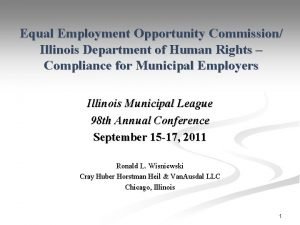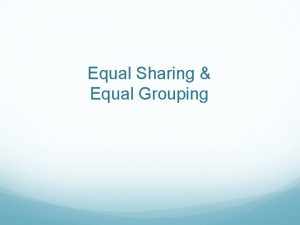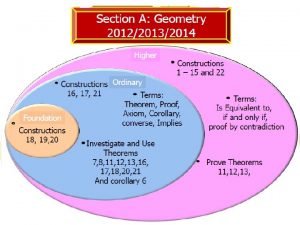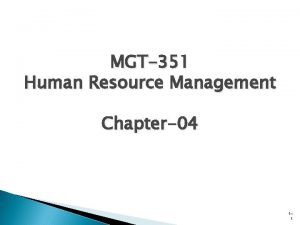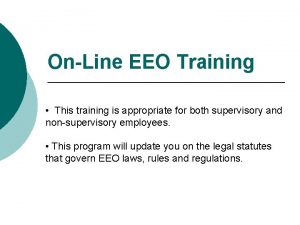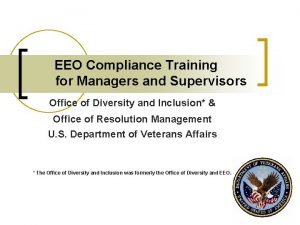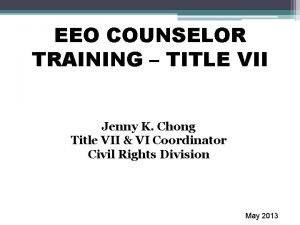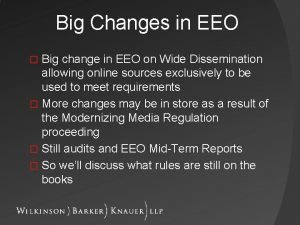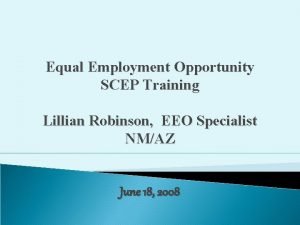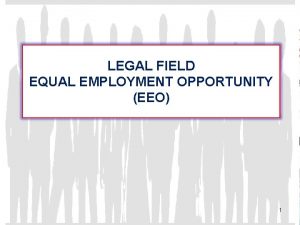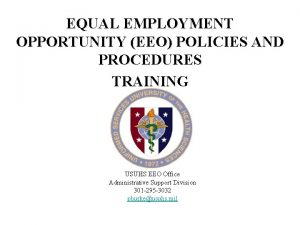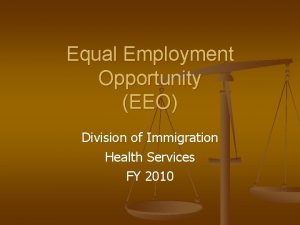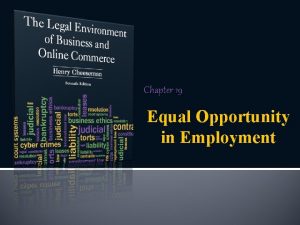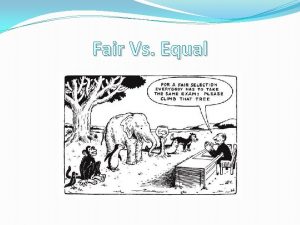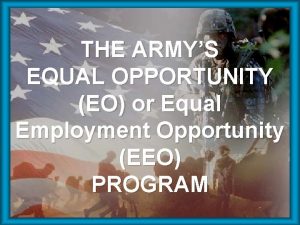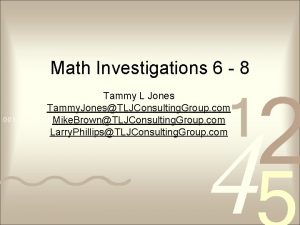Equal Employment Office Tammy Lowery Deputy EEO Officer















- Slides: 15

Equal Employment Office Tammy Lowery Deputy EEO Officer vacant Equal Employment Opportunity Specialist Excellence Through Knowledge

What is EEO? • Equal Employment Opportunity (EEO) is fair treatment in employment, promotion, training, and other personnel actions without regard to race, color, religion, sex (including pregnancy, gender identity, sexual orientation), age, national origin, physical or mental disability, genetic information, or reprisal for previous EEO activity. 2

EEO LAWS • Primary EEO Laws – Title VII of the Civil Rights Act (CRA) of 1964 as amended to include The Pregnancy Discrimination Act – Age Discrimination in Employment (ADEA) 1967 – Equal Pay Act (EPA) of 1963 – Rehabilitation Act of 1973 – Americans with Disability Act (ADA) of 1990 as amended in 2008 & 2009 – Title II of the Genetic Information Nondiscrimination Act (GINA) of 2008 3

EEO Regulations and Guidelines • 29 CFR 1614: Governs the federal sector for the EEO program including complaints processing. It states that each agency will maintain a continuing affirmative program to promote EEO and to identify and eliminate discriminatory practices and policies. • EEOC Management Directive 110: Describes in detail the procedures that must be followed when processing complaints of discrimination filed by federal employees and applicants for federal employment who allege employment discrimination under the amended 1614 regulations. • EEOC Management Directive 715: Establishes guidance for federal agencies for establishing and maintaining effective programs of equal employment opportunity. 4

Basis of Discrimination • The characteristics of an individual which he or she believes is the reason a particular employment action has been taken against him or her based on: q. Age (40 and above) q. Sex (Gender/Sexual Orientation/Sexual Harassment/Pregnancy) q. Race q. Religion q. Reprisal (for prior EEO activity as a complainant or witness) q. Color q. Genetic Information q. National Origin q. Disability/Physical or Mental Impairment 5

Discrimination - Other Factors – Protected categories outside of EEO process: • Political Affiliation • Marital Status • Parental Status • Veteran’s Status – Methods of redress for the above factors: • Administrative Grievance Procedure • Office of Special Counsel (OSC) • Merit Systems Protection Board (MSPB) 6

Pre-Complaint Process 7

Formal Complaint Process 8

Harassment • Harassment is unwelcome conduct that is based on Title VII of the Civil Rights Act of 1964. • Harassment becomes unlawful where: – 1) enduring the offensive conduct becomes a condition of continued employment, or – 2) the conduct is severe or pervasive enough to create a work environment that a reasonable person would consider intimidating, hostile, or abusive. – Anti-discrimination laws also prohibit harassment against individuals in retaliation for EEO activity. 9

Sexual Harassment • A form of discrimination that involves unwelcome sexual advances, requests for sexual favors and other verbal or physical conduct of a sexual nature when it is made a term or condition of a person’s job, pay or career, or creates an intimidating, hostile or offensive environment. Learn more at https: //nps. edu/web/eeo/sexualharrassment 10

Reasonable Accommodation • Modification or adjustment to a job or the work environment that will enable a qualified applicant or employee with a disability to participate in the application process or to perform essential job functions without causing undue hardship on to the agency. • Who is covered: – applicants for employment/current employees having a physical or mental impairment that substantially limits one or more major life activities OR has a record of such impairment OR is regarded as having such an impairment. Learn more at https: //nps. edu/web/eeo/reasonableaccommodation and https: //askjan. org/ 11

The EEO Program Also Includes: Alternative Dispute Resolution (ADR) Services Used for complaints alleging discrimination and non-EEO related matters Mediation A neutral 3 rd party from an outside agency will mediate workplace disputes. Any procedure used in lieu of litigation or a formal administrative process to resolve issues in controversy. Conflict Coaching A coach helps individuals one-on-one in up to to six sessions with communication and negotiation skills to better prepare them for mediation. Group Facilitation A collaborative process used to help a group of individuals with divergent views reach a goal to the satisfaction of all. A facilitator is a trained neutral who keeps the meeting on track, makes sure people get a chance to speak, in an orderly manner enforces any established ground rules, and stimulates discussion by asking questions. Learn more at https: //nps. edu/web/eeo/alternative-dispute-resolution-adr 12

The EEO Program Also Includes: • Special Emphasis Programs and Observances – Such as Black History Month, Women’s History Month, Disability Employment Awareness Month, etc. • Affirmative Employment Program – Dedicated to improving the employment and advancement opportunities for women, minorities, individuals with disabilities and veterans. • Diversity Programs – NPS values diversity through awareness, education and positive recognition of cultural differences within the workplace. 13

No FEAR Act • • • The “Notification and Federal Employee Antidiscrimination and Retaliation Act of 2002, ” is now known as the No FEAR Act. One purpose of the Act is to “require that Federal agencies be accountable for violations of anti-discrimination and whistleblower protection laws. ” In support of this purpose, Congress found that “agencies cannot be run effectively if those agencies practice or tolerate discrimination. ” The Act requires that DON inform current employees, former employees and applicants for employment, of the rights and protections available under Federal antidiscrimination, whistleblower protection and retaliation laws. The No FEAR Act Includes protection under the following categories: – – Antidiscrimination Laws; EEO or OSC Whistleblower Protection Laws Retaliation for Engaging in Protected Activity Disciplinary Actions 14

Questions? QUESTIONS? • EEO POC’s: – Tammy Lowery, Deputy EEO Officer • Tammy. lowery@nps. edu or 831 -656 -3600 – vacant, EEO Specialist • @nps. edu or 831. 656. 3052 Additional Information • For further information regarding the No FEAR Act regulations, on the website http: //www. secnav. navy. mil/donhr/Site/Pages/No-Fear-Act. aspx • Additional information regarding Federal antidiscrimination, whistleblower protection and retaliation laws can be found at the EEOC Web site--http: //www. eeoc. gov and the OSC Web site -- http: //www. osc. gov. 15
 Lois lowery
Lois lowery Our love now martyn lowery
Our love now martyn lowery Equal opportunity illinois
Equal opportunity illinois Meridionalnet
Meridionalnet Taku komura
Taku komura Equal sharing and equal grouping is called
Equal sharing and equal grouping is called Opposite angle
Opposite angle Equal height equal light
Equal height equal light Eeo principles australia
Eeo principles australia Job description and job specification in hrm
Job description and job specification in hrm Online eeo training
Online eeo training Eeo 1 report remote employees
Eeo 1 report remote employees Eeo pre award clearance
Eeo pre award clearance Eeo compliance training
Eeo compliance training Eeoc training for managers
Eeoc training for managers Eeo counselor training
Eeo counselor training


